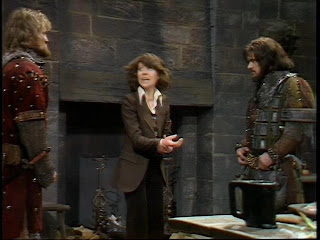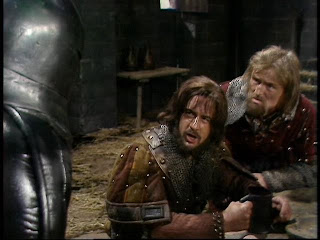The Time Warrior stands at an interesting point in Doctor Who's history, and is an important story. First off, it has an awesome new title sequence, created with the slitscan technique from 2001: A Space Odyssey and introducing the logo that would become synonymous with Tom Baker's era.
It's the opening of the 11th season, which producer Barry Letts and script editor Terrance Dicks decided would be their last. It's clear even here that their era is coming to an end. With Roger Delgado tragically killed in a car accident, the Master was no longer the kind of recurring character he had been, and wouldn't be seen again for several seasons. Jo Grant, who had been the Doctor's companion for three years, had exited at the end of The Green Death the previous season. UNIT no longer carries the importance of the previous four seasons. The Brigadier gets a few good exchanges with the Doctor at the beginning, but disappears before the end of the first episode.
The Time Warrior is also one of the earliest "pseudo-historicals", the tales set in Earth's past but with a sci-fi plot. It had been done a few times before - The Time Meddler is probably the best example - but in general, it was still a fairly rare concept. Nowadays, it takes up about a third of every season... It also introduces the Sontarans, a race who define themselves entire through war.
But none of that is what makes this episode really important. No, what truly makes this one of the turning points of the show is the companion: Sarah Jane Smith.
Sarah Jane is the perfect template for a companion. She's strong, brave, resourceful, and independent. She gets captured in this story, but she always breaks herself out; she doesn't need the Doctor to rescue her. In fact, she rescues the Doctor on more than one occasion. She shows supreme self-confidence, and is more than willing to cut the Doctor down to size. Here, in her first adventure, she spends much of the story believing the Doctor to be the villain, and takes a long time (understandably) to fully trust him. It's a blast to watch her carry so much of the story through her own strength. And she abjectly refuses to make coffee for the Doctor.
But she can also be vulnerable and scared when necessary. Elizabeth Sladen is wonderful throughout. She was cast for her ability to show both fear and courage at the same time, something she does superbly, but Sladen pours herself into every moment of the role. Her first scene, meeting the Doctor, is terrific. He almost immediately sees through her cover story for sneaking into a top secret science complex, but she just as quickly figures out that he probably won't give her away; her knowing smile when she asks him why he won't give her up is a perfect touch. Later in the story, I love the scene where she meets Irongron, and is so fiery that he decides not to throw her in the dungeon and just leaves her standing around for awhile so her antics can amuse him. She's funny, wistful, and just totally charming. And she has great chemistry with Pertwee; it's just a blast to watch them together. She's completely engaging and full of personality, and single-handedly elevates the tale.
Not that it isn't good anyway. It's a Robert Holmes script, and as expected, it's more dialogue-driven than anything else, but what awesome dialogue!
The Doctor: A straight line may be the shortest distance between two points, but it is by no means the most interesting,
Sarah Jane: You're serious, aren't you?
The Doctor: About what I do, yes. Not necessarily about the way I do it.
Linx: What is this?
Irongron: Oh, just a girl, taken in the forest.
Linx: Girl? You have two species on this planet?!
Irongron: How say you?
Linx: The girl is not of your kind, Irongron. The hair is finer, the thorax of a different construction...
Irongron: Oh, Hell's teeth, have you no girls beyond the stars? No women to do the lowly work?
Linx: Ah, I understand. You have a primary and secondary reproductive cycle. It is an inefficient system. You should change it.
Sarah Jane: Oh, I could murder a cup of tea.
He does a nice job with the medieval dialogue - it's wordy enough to sound convincingly old-fashioned but not so much it's ever confusing or distracting. More importantly, it has as much wit and style as the more modern dialogue. And as you'd expect from Holmes, The Time Warrior has a gallery of great characters.
The villains are a blast together. The arrogant Irongron thinks he's far, far smarter than he really is, and keeps trying to undermine the technologically and intellectually superior Linx, and gets by with a couple minor victories in their verbal sparring through sheer persistence. David Daker is hilarious as the bandit, but manages to be intimidating and threatening as well when need be.
Linx is the more memorable of the two, though, as the first Sontaran to show up in Doctor Who. Despite a few rough edges, the makeup design is excellent, and makes him one of the most convincing aliens on the show. And the race itself is interesting: a clone race of warriors, inherently tough physically anyway, but with the addition of their armor, incredibly difficult to kill except for a small vent on the back of the neck. They prefer it that way, so that they're always forced to face forward in battle, and can never retreat. Very cool.
The third villain, Bloodaxe, is Irongron's right hand man, and thinks he's pretty much the coolest guy in the entire world, and remains completely oblivious to what an idiot his boss really is. John J. Carney is highly amusing in the role.
Irongron: I'll chop him up so fine not even a sparrow will fill its beak!
Bloodaxe: [in awe] Yours is indeed a towering intelligence!
There are two other major supporting characters. The first, Rubeish, is a charming, witty variation on the absent-minded professor. He's so near-sighted that, because he doesn't have his glasses, Linx can't hypnotize him, allowing him to help the Doctor to what little extend his near-blindness allows. Mostly, though, he just adds to the overall sense of fun.
Rubeish: I haven't seen my wife and family for three days.
Doctor: Well, I'm sorry to hear that.
Rubeish: Ah well. Just shows there's always a silver lining.
The other is Hal the archer, played forcefully and charismatically by Jeremy Bulloch. He's likable and engaging enough that he might have even made a pretty good companion, though with Sarah Jane around, he wasn't really needed.
The less important characters are also good - the Lord and Lady of the nearby castle, despite only having a few scenes, have a well-developed relationship and personalities. You get a real sense of who they are in just a handful of lines. Even minor one-sceen characters are interesting individuals - they all have interesting things to say and do and add to the setting.
And, of course, there's the Doctor, who's as brilliant as ever. Pertwee is at the top of his game, swinging from chandeliers, passionately decrying evil, wittily cutting down his opponents, and just generally being the dashing, heroic figure he so perfectly created in his version of the character.
Director Alan Bromly generally does a good job giving a dialogue-dirven script plenty of energy and capturing the midieval atmosphere well enough. Unfortunately, though, while it's a perfectly adequate approach, he doesn't bring any passion to his storytelling. In particular, he doesn't seem terribly interested in the action scenes - they're competantly staged but indifferently shot and edited, and as a consequence, exciting enough but nowhere near as thrilling as they should be. Barry Letts tells a story that for the climax, which called for a castle to be blown up, he told Bromly that they could, in fact, blow up a model castle (and it's worth noting here that blowing up models is the one special effect that Doctor Who consistently does well) ... and Bromly turned it down, saying he would cut it together in a way that would work. He spliced in two seconds of a quarry blowing up.
Bromly should have been ashamed of himself. NOTE TO ALL DIRECTORS OF ANY AND EVERY FILM OR TELEVISION MEDIUM: If your producer tells you that you have the resources, money, and time to film the massive explosion your climax calls for, don't turn him down. That may just be the worst decision every made by any director in the history of television, possibly excepting the entirety of the Star Wars Christmas Special. Seriously, what was Bromly thinking?
Point being, the climax, while not unexciting, isn't the thrill ride it should be, despite big stunts, various acts of derring-do, treachery, archery, and a castle blowing up (or what was supposed to be a castle blowing up). But, to be fair, Holmes doesn't come up with a perfect conclusion. (though the castle blowing up was an excellent idea, Bromly) It's satisfying enough, but the Linx/Irongron double-act doesn't fully pay off, and there's nothing particularly memorable about the way he wraps up outside of those few elements Bromly botches. Really, though, it's more Bromly than Holmes; with a Douglas Camfield or David Maloney or Graeme Harper directing, I'm sure it would have been terrific. Heck, if Letts himself had directed it like he originally planned, it would have been great.
Ultimately, The Time Warrior has all the elements of a classic, but falls short due to Bromly's lack of adventurousness and Holmes not quite figuring out how to wrap things up. But it's a total delight nonetheless, consistently entertaining and a lot of fun, and is a must-see for the introduction of the greatest companion the Doctor ever had in Sarah Jane Smith.
RATING:
* * *
SIDENOTES:
- Jeremy Bulloch is probably best known for playing Boba Fett in the original Star Wars films, but he also played another character in Doctor Who about ten years earlier in The Space Museum, although that role mostly just asked him to stand around with his arms akimbo. He's much, much better here with an actual role.
- The DVD is one of the occasional releases where the Restoration Team added CGI effects to try to make up for the low-budget old ones. While I certainly appreciate their efforts, I've always found these to be a bit hit-or-miss. When they work, they lift the story to an even higher level - Dalek Invasion of Earth and Earthshock come to mind. But too often, they're jarring because the CGI often looks like CGI. This, unfortunately, is one of those cases. Yes, it's nice to see the castle blow up, but they're too obviously CGI flames. Yes, it's nice to see the spacecraft flying toward the earth, but it looks just as cheap as the original shots, even if they are a tad more dynamic. But hey, you can't get it right all the time, and I'm really glad for the times when their additions work. (and I'm really looking forward to their version of Day of the Daleks) And I'm especially glad that they consistently make the original version the default way of watching, and their altered versions in the special features.





















No comments:
Post a Comment